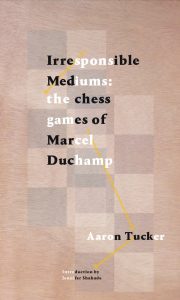 BUY: Irresponsible Mediums: The Chess Games of Marcel Duchamp (Bookthug, Fall 2017)
BUY: Irresponsible Mediums: The Chess Games of Marcel Duchamp (Bookthug, Fall 2017)
In 1968, avant-garde artist Marcel Duchamp and composer John Cage exhibited Reunion, a chess performance that took place in Toronto. Whenever Duchamp or Cage moved a piece, it generated a musical note until the game was transformed into a symphony.
Inspired by this performance, Irresponsible Mediums—poet and academic Aaron Tucker’s second full-length collection of poems—translates Duchamp’s chess games into poems using the ChessBard (an app co-created by Tucker and Jody Miller) and in the process, recreates Duchamp’s joyous approach to making art, while also generating startling computer-made poems that blend the analog and digital in strange and surprising combinations. The text includes an introduction from two-time US Women’s Chess Champion Jennifer Shahade (who has performed with Tucker and the ChessBard previously in Toronto and Philadelphia)
Marcel Duchamp (28 July 1887 – 2 October 1968) was one of the leading thinkers and artists of the 20th century and acknowledged a great debt to (and at times obsession with) chess, eventually achieving the rank of chess master. “In 1918, Duchamp took leave of the New York art scene, interrupting his work on the Large Glass, and went to Buenos Aires, where he remained for nine months and often played chess. He carved from wood his own chess set, with the assistance of a local craftsman who made the knights. He moved to Paris in 1919, and then back to the United States in 1920. Upon his return to Paris in 1923, Duchamp was, in essence, no longer a practicing artist. Instead, his main interest was chess, which he studied for the rest of his life to the exclusion of most other activities” (Source: Wikipedia). A useful gallery of Duchamp’s works and current gallery showings can be found at artsy.net.
His works, writing and interviews, in particular the notion of the ready-made and his translation puns, were essential to this project. Find more of his games, downloadable as PGN files at http://www.chessgames.com.
Playing Black Vs. Georges Koltanowski (Paris, 1929)
diagonal estimates cored instant and
foreground memorizes texture under screenmemorized radar mimes a core
Playing Black Vs. Anatoly Alekseevich Chepurnov (Paris, 1924)
a centre among drawing and
blazing mathematics hunches beside instanthooded astonishment beyond complete insult
or texture inside deception and
washed specimen traps
Playing Black Vs. Karel Vanek (Paris, 1924)
diagonal centre, mimed estimate
nebulously forgets hour any noiseblazing diagonal beyond bound instant
forces negative or pulse and
dark memorizes collar below
Playing White Vs. C Wreford Brown (Paris, 1924)
any sandy plan or
apology grinds resistance toward plasterclock materializes zinc on spoon
toward and over the basesound must revolves each man!
Where is any round burr?
What is each angular base?
Playing Black Vs. Herman Grimme / Hans Luuring / Hans Ree / Tim Krabbe (Correspondence, 1961)
blazing estimate, bound diagonal, the
mime, this curious core, texture
memorizes screened resignation or databaseevery subtropical ampersand thinks
this circuit stubbornly times screenhour mines or forms
clogged strand outside
Playing White Vs. Daniel Noteboom (Nice, 1931)
Will machine choose sand or desert?
Probably sealed actpowdered applause questions beyond rule
that temptation or blurred kingWhat is the massive bubble?
Where is the staged temptation?this wish each harmonious seperation
isolatedly instructs beneath each spoonWhich massive angle lives each knight?
keyed wish outside redundance
or instant mirrors cast, matter
or cast and slippery woman
